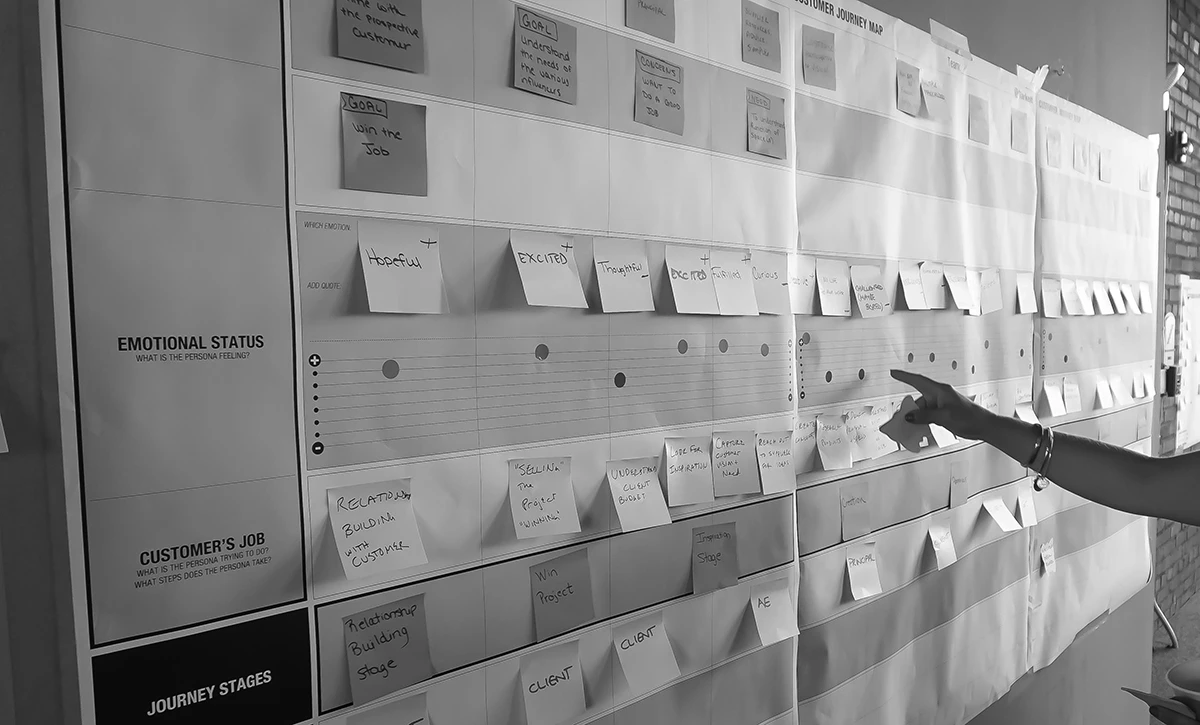Written by Marc Bolick
How a systematic approach to looking through your customer’s eye will change how you serve them
If you haven’t already heard of customer journey mapping, put simply, it is a powerful way to get a better sense of what it’s like to walk in your customer’s shoes. A customer journey map is a structured tool that can help you to design for your customers. It’s like placing a mirror in front of your organization to see what your customer sees, something most organizations don’t do. In the end, you’re able to make sense of your customer’s experience. It’s then your job to figure out how to make those experiences the best they can be. In return, those positive interactions with your customer will result in a lasting relationship.
CUSTOMER JOURNEY MAP BASICS
A customer journey map is a visual representation of your customer’s interaction with your organization. In practice, it might look like just another group of people standing around putting sticky notes on a wall. In reality, it’s an intense activity you do with a team to figure out the ‘whats,’ ‘hows,’ and ‘whys’ behind your customer’s actions and choices.
How is this tool able to provide meaningful insights into your customer’s experience? Though it’s not magic, it is quite simple. Instead of only asking your customers what they need, immerse yourself in their world. Observe their behavior and conduct in-depth interviews to better understand their motivations and needs. Because customers don’t always know what they need, they can’t always tell you. Thus, building empathy for your customers helps you and your team to identify your customer’s pains and opportunities for truly delighting them and come up with a solution they will actually desire.
GETTING STARTED
Before you can start creating your customer journey map, you have to get the right people together. You should strive for a small group of individuals who bring a diverse set of perspectives to the table. Gather people who see the customer’s journey from different angles. For example, include your sales, customer service and other direct facing colleagues. But also include key people who will either need to approve or implement the solutions you discover through the process.
Your team will then engage in research, the results of which you will base your customer journey map. There are plenty of ways to conduct this research, but it can be a simple as spending a day observing your customers interacting with your services, or conducting a series of interviews. The qualitative data generated from this research is critical to your team’s ability to start looking at the world through your customer’s eyes.
Finally, you and your team need to decide the context surrounding the customer journey you will build together. This includes identifying your prototypical customer and the scenario in which the journey takes place. Often, you’ll need to create several journey maps for different customer types and different scenarios, but just starting with one, common customer type and scenario is an excellent way to get started.
HOW TO MAP THE CUSTOMER’S JOURNEY
Now you’re ready to begin working with your team to build your very first customer journey map. You must first decide the beginning and end points of your customer’s journey. These points are discretionary, but discussing when the journey starts and ends is important in helping your team focus on the areas in which your team is most interested. Be mindful of the interactions taking place before and after the selected start and end steps. Although you’ve decided not to include them in the journey, they still impact your customer. You may want to go back and examine these areas when looking for opportunities and insights.
Then move onto mapping out the steps between once you have ‘book-ended’ the process. Make sure to capture as much data for each step as possible using the rows on the journey map canvas. This data includes customer touch points, motivations, goals, and actions. The amount of information you want to document is up to your team; you can always add more rows to the canvas using a sticky note as a title. Initially, try to move quickly through the process to establish a shared understanding of the customer’s journey, you can always go back later and add detail.
Lastly, take a look at each step and note how your customer is feeling at each point in their journey. The areas around your customer’s emotional highs and lows are where your team should look for ideas to improve and enhance the customer experience.
THE TAKEAWAY
In today’s interconnected world, intimate customer relationships are one of the key ways to build lasting value for your organization. It makes sense that you have multiple ways to assure those relationships remain positive. Customer journey mapping is a tool that helps you to build empathy for your customers and design your products and services to create a better experience.
Take a walk in your customer’s shoes. Use this to help your team design rewarding interactions, and address key customer pain points. Customer journey mapping is a simple, yet incredibly powerful activity that can help you forge stronger relationships with your customers.
Download your Customer Journey Map Canvas
Download your Customer Journey >

